Sonorous III
back to Final
back to measurements
home
published: Jul-8-2017
NO SMOOTHING is applied to the shown plots. Most measurement sites have some smoothing applied which ‘irons flat’ sharp peaks and ‘wiggles’. I do not use smoothing because some info about sound quality is lost when plots are smoothed.
Aside from a small correction of the microphone itself also some correction in the lowest frequencies is applied to the plots to compensate for the perceived loss of bass when using headphones. This is described HERE in more detail.
A ‘horizontal‘ frequency response curve on the shown frequency response plots on this website thus indicates a perceived ‘flat’ tonal signature.
ALL measurements are made with a good SEAL on a flatbed measurement rig.
The shape of your head, bone structure, pad size, pad ‘softness, (compliance), hair or no hair and or wearing glasses may (drastically) change the frequency response of some headphones, so… your personal experience may differ substantially from these plots.
Frequency response (tonal balance) is the most sound-determining aspect of headphones. A horizontal line shows audible neutral response in the plots on this website. Deviations in different severities at different frequency bands have an effect on the sound character.
The bigger the deviation the stronger the effect.
Below an aid to help determining the sound character of headphones with relation to the frequency response.

Final Sonorous III

The Final Sonorous III is a closed dynamic headphone. This is a bulky and old looking design. Those knowing about the brand Final will know there is quite a cult following this brand.
There are some strange looking models and run up to crazy prices as well.
Lets just say the brand is not for everyone. This one is still affordable and priced around €380.-
The series now called ‘Sonorous’ was named ‘Pandora Hope’ but the name was changed due to a request from the US streaming service Pandora.
The headphone is quite bulky and will accommodate for big ears as well.
The cable is quite microphonic alas. You can hear the cable rub against clothes etc. The headband is soft but has a small contact surface area which takes away some of the comfort. Even though this is a closed headphone it manages to leak sounds both ways.
A bit like the Denon Dx000 series.
With its 16Ω impedance it doesn’t need a lot of voltage to play loud and thus suited to be driven from portable sources.
specifications:
Type: Over ear, closed
Usage: Portable, commuting, office and home.
Driver type: dynamic with a titanium dome.
Pads: pleather (fake leather)
Foldable: No
Headphone connector: 3.5mm TS (mono) locking
Cable entry: dual
Cable: 1.6m 3.5mm TRS (+ 6.3mm adapter) to 2x 3.5mm locking TS 3.5mm
Driver size: 50mm
Max. power rating: not specified
Max. S.P.L. not specified
Impedance: 16Ω
Efficiency: not specified
Weight: 450 g. (with cable)
Clamping force: medium low.
Accessories: Instruction manual (multi language), 6.3mm adapter
Measurements:
Below the frequency response of the Sonorous III (Left, Right)
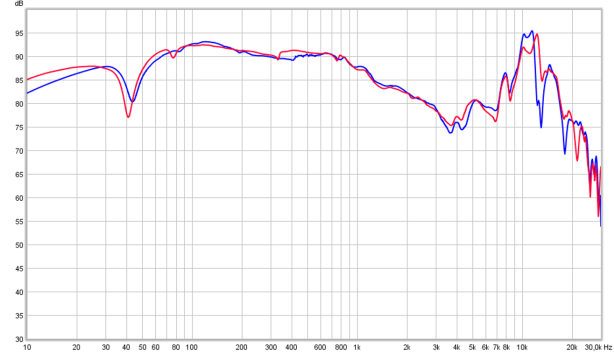
The dip around 40Hz is most likely something in the measurement and not really there. It has a slight warmish tilt to it as the plot is sloping downwards from 200Hz to 1kHz.
Above 1kHz it drops down further and at a greater angle. This points to less clarity than ‘neutral’. Some people prefer such a tonal character over ‘neutral’. I am not one of them. The treble range is a bit odd as it is just a peak (centered around 11kHz) sticking out a few dB above the mids. It drops off above 16kHz. Usually indicating a lack of ‘airy-ness’ The treble is somewhat disconnected but still there. Overall a bit subdued yet at certain frequencies isn’t. The small peak may give some ‘harshness’ to certain instruments and make some instruments sound less realistic.
Final headphones are usually ‘tuned’ to have a certain character, flat and realistic usually is not one of their favorite tunings.
output resistance / damping-factor
As this is a low impedance (16Ω) dynamic headphone the frequency response may change when used with a higher output resistance (desktop) amplifier and given its low impedance could even happen with higher output resistance portable sources.
To test this the headphone is measured via a low impedance amplifier (0.2Ω) and a high impedance amplifier (120Ω). On a higher output resistance amplifier the output level will be considerably lower. To compensate for this the amplifier is cranked up to the same level (at 1kHz) as the low impedance amplifier. This way the plots are overlay-ed and it is easy to see how the tonal balance changes.
Right channel only, driven from 0.2Ω and 120Ω amplifier.
As can be seen the difference is negligible over the entire frequency range except some very small (< 1dB and inaudible) deviation in the mids. So the sound signature won’t change at all when a higher output resistance source is used.
It also means that the used drivers are mostly mechanically damped and do not rely on electrical ‘damping’.
Below the distortion plots of the Sonorous III: (only Right channel shown)
The distortion products are shown in dB.
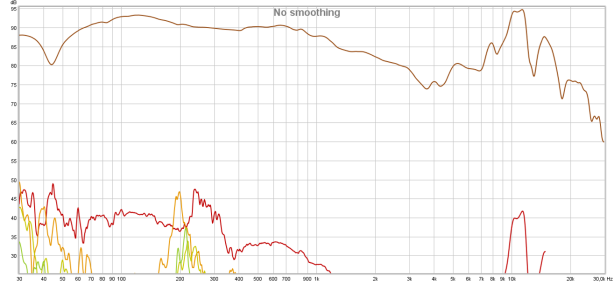
As can be seen in the plots the higher amount of distortion in the bass is typical for dynamic drivers. Fortunately high amounts of 2nd harmonic distortion aren’t perceived as such but rather as a ‘warming’ of the bass.
Note that this headphone was measured at ![]() where unavoidable background noises were present in the demo room. Distortion levels and spectrum plot performance may thus be better in reality than shown on the plots.
where unavoidable background noises were present in the demo room. Distortion levels and spectrum plot performance may thus be better in reality than shown on the plots.
Below the same plot except shown in percentages.
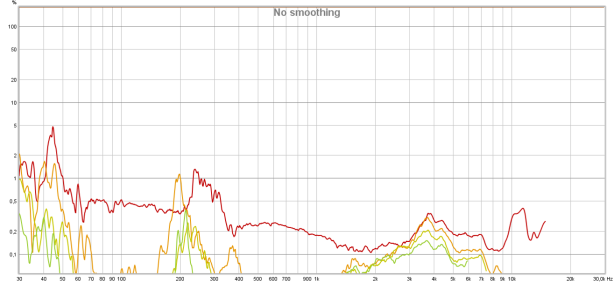
It shows the bass distortion is quite good and remains below 1%. The peaks around 200 and 250Hz may not be there and are most likely caused by ambient sounds.
Below the CSD of the Sonorous III (Left and Right channel are superimposed)

The ringing for the mids is quite good. The treble area around 10kHz consists of several short lived resonances. The resonances are very short lived and won’t be very problematic.
When driven from a higher output resistance amplifier nothing changes that much.

Above the CSD of the Sonorous III (right channel) via a 0.2Ω output resistance amplifier and also when connected to a 120Ω amplifier.
Below the spectrum plot of the Sonorous III. (left channel)
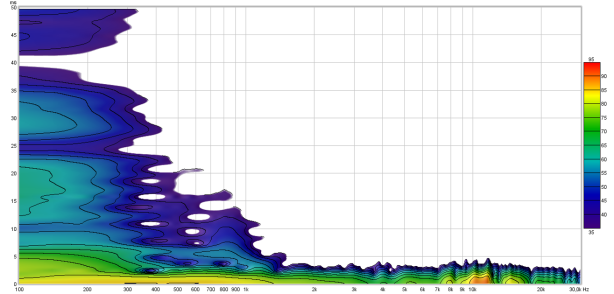
This plot shows bass is pretty well damped. This plot looks pretty good and doesn’t show any long and sound degrading resonances.
By lack of oscilloscope shots (not enough time to measure that) below a step response plot of the Sonorous III. (Left channel)
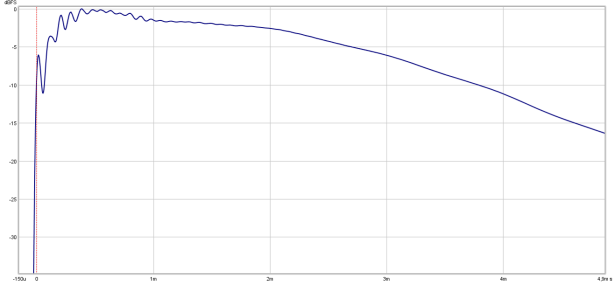
On the left you can see that there is some overshoot and some ringing. The rising edge not reaching the top indicates that it has a ‘dark’ tonal character. Sub-bass response is there but slightly lower than the bass/mid-bass in level.
This is a quite decent step response. Below the Right channel.

summary
The Final Sonorous III is aimed at the home market. Due to its low impedance it can also be used for commuting. In that case you should take into consideration that the cable is microphonic which may be annoying when walking around with it. It does leak some sound so less suited for office duties or places where sound leakage is not appreciated.
When you like the looks (quite bulky, not really fashionable outside of Japan ?) and the tonal character, which is darker than ‘neutral’ and love mids than this headphone may be a viable option.
